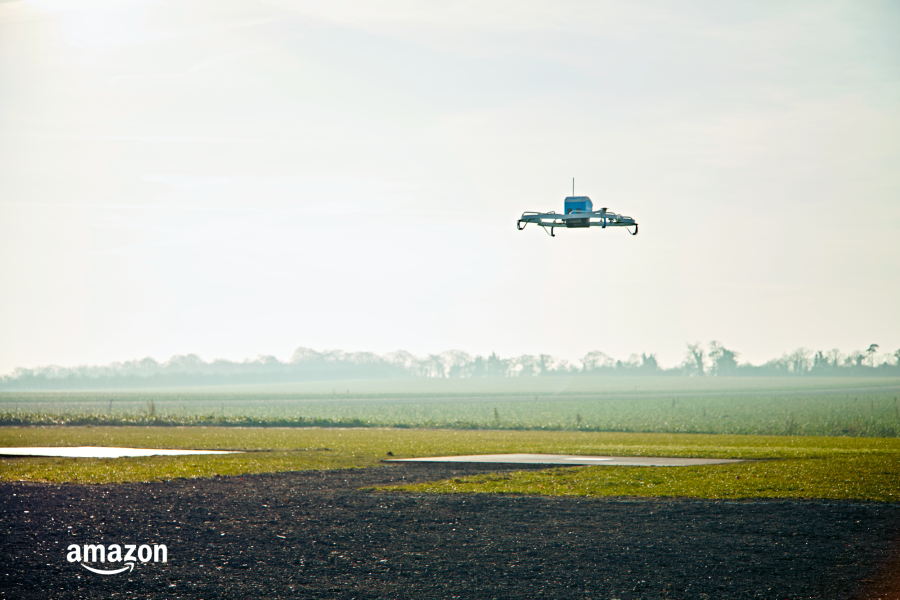Amazon drone makes its first commercial delivery. Will more follow?
Loading...
Amazon made history last week with a Fire TV Stick and a bag of popcorn.
The online retailer became the first major company to deliver a package via drone when it left a 4.7-pound box with the two items in a backyard near Cambridge, England, on Dec. 7, according to a video chief executive officer Jeff Bezos posted on Twitter Wednesday.
“We’re starting with two customers now and in the coming months we’ll offer participation to dozens of customers living within several miles of our U.K. facility, and then growing to hundreds more,” said the video narrator. “After that, well it’d be easy to say the sky’s the limit, but that’s not exactly true anymore, is it?”
The delivery marks a milestone for Amazon, as it competes to make the delivery of packages, medicine, and even burritos as quick as ordering pizza. Since Mr. Bezos announced in 2013 Amazon’s intention to introduce drone delivery in four to five years, it and the likes of Wal-Mart, UPS, and Google parent Alphabet have vied to develop the technology and clear regulatory hurdles to make it mainstream. How fast this service reaches customers, however, will depend on where they live, as different countries have adopted very different stances on drone delivery.
The first customer to receive a package, identified as Richard B. in the video, lives near Amazon’s testing facility in Cambridgeshire. Moments after he places his order in the video, The Amazon Fire TV Stick and popcorn are packaged and shuttled into a quad-copter drone. A small flatbed mounted on a rail ferries the drone outside where it is launched.
Guided only by GPS and sensors, the drone quietly flies less than 400 feet above the English countryside, touching down behind Richard’s home 13 minutes after he places the order. The drone then returns to the facility.
The delivery occurred in England because Amazon was able to work with British regulators to privately test a drone program. The country’s Civil Aviation Authority approved in July Amazon rolling out the program in rural and suburban England in order to troubleshoot the program. The regulator exempted Amazon from certain regulations, such as only flying within the line of sight of a drone operator, according to The Wall Street Journal.
"We will use the data gathered during this beta test and the feedback provided by customers to expand the private trial to more customers over time," the video narrator said.
The delivery program, known as Prime Air, will be available to customers who live within a five-mile radius of the fulfillment facility once the program expands. They will be able to receive deliveries during daylight hours seven days a week, with Amazon stating its goal is to deliver packages in 30 minutes or less. The items must weigh less than five pounds, but an Amazon spokeswoman told The Wall Street Journal up to 87 percent of the items sold on its site are under that weight limit already and are small enough to be carried by a drone.
Other countries are allowing Amazon and others to move ahead with drone delivery tests. Canada and the Netherlands are the site of such tests for Amazon, according to a statement from Bezos.
Nevada also played home to the first ever drone delivery in July. That feat was accomplished by the startup Flirtey Inc. The company, in partnership, with 7-Eleven, flew a package from a convenience store in Reno to a nearby household. The contents of the package were Slurpees, a chicken sandwich, donuts, hot coffee, and candy, according to a statement from 7-Eleven.
Flirtey also started to deliver Domino’s Pizza via drone in a small test in New Zealand, while UPS had its own small commercial test to deliver medicine to difficult-to-access or remote areas, such as an island near Boston.
But these small achievements aren’t likely to translate to hundreds of drones taking to US skies anytime soon. The US Federal Aviation Administration was conservative in the regulations it released earlier this summer. In the US, drone operators are required to always be within the line of the site of the drone, which prevents the kind of delivery testing Amazon envisions.
But Amazon has indicated it hopes the data it and other companies collect from these test flights will convince regulators around the world drones’ radio links, collision-avoidance technology and guidance systems are reliable and safe.







